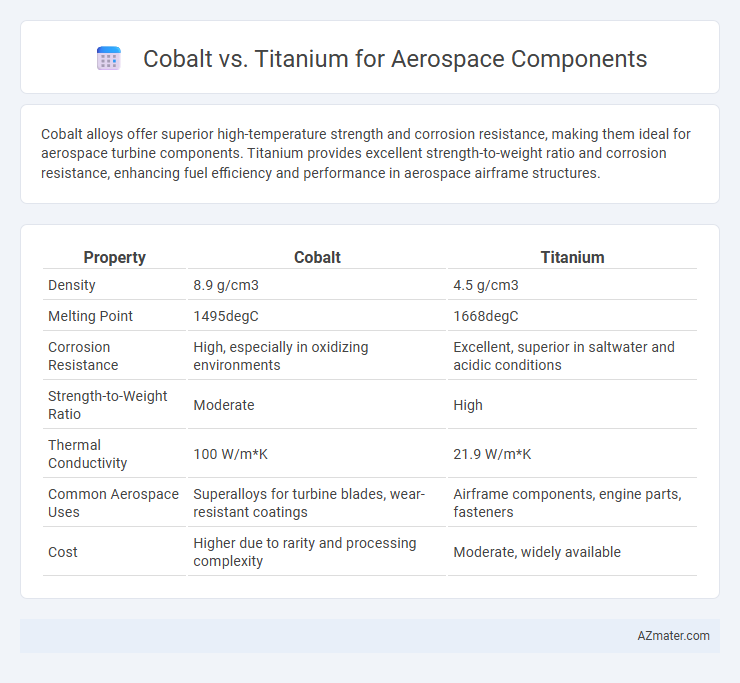Cobalt alloys offer superior high-temperature strength and corrosion resistance, making them ideal for aerospace turbine components. Titanium provides excellent strength-to-weight ratio and corrosion resistance, enhancing fuel efficiency and performance in aerospace airframe structures.
Table of Comparison
| Property | Cobalt | Titanium |
|---|---|---|
| Density | 8.9 g/cm3 | 4.5 g/cm3 |
| Melting Point | 1495degC | 1668degC |
| Corrosion Resistance | High, especially in oxidizing environments | Excellent, superior in saltwater and acidic conditions |
| Strength-to-Weight Ratio | Moderate | High |
| Thermal Conductivity | 100 W/m*K | 21.9 W/m*K |
| Common Aerospace Uses | Superalloys for turbine blades, wear-resistant coatings | Airframe components, engine parts, fasteners |
| Cost | Higher due to rarity and processing complexity | Moderate, widely available |
Overview of Cobalt and Titanium in Aerospace
Cobalt alloys in aerospace are valued for their exceptional wear resistance, high-temperature strength, and corrosion resistance, making them ideal for turbine blades and engine components exposed to extreme environments. Titanium offers an outstanding strength-to-weight ratio, corrosion resistance, and fatigue durability, which is critical for airframe structures and fasteners in both commercial and military aircraft. Both metals are essential in aerospace engineering, with cobalt favored for hot-section engine parts and titanium dominating in lightweight structural applications.
Material Properties Comparison
Cobalt alloys offer superior wear resistance and high-temperature strength, making them ideal for aerospace turbine blades and engine components exposed to extreme heat and stress. Titanium alloys provide excellent strength-to-weight ratio, corrosion resistance, and fatigue performance, which are critical for airframe structures and fasteners where weight reduction is essential. The choice between cobalt and titanium depends on balancing thermal durability with lightweight design requirements in aerospace applications.
Weight Considerations: Cobalt vs Titanium
Titanium offers a significantly lower density, approximately 4.5 g/cm3, compared to cobalt's density of about 8.9 g/cm3, making titanium a preferred choice for aerospace components where weight reduction is critical for fuel efficiency and performance. The high strength-to-weight ratio of titanium alloys enables the production of lighter yet durable parts, reducing overall aircraft weight and contributing to enhanced payload capacity. In contrast, cobalt's higher weight limits its use primarily to applications requiring extreme wear resistance or high-temperature stability rather than weight-sensitive structural components.
Strength and Durability in Aerospace Applications
Cobalt alloys exhibit superior high-temperature strength and excellent wear resistance, making them ideal for turbine blades and engine components requiring prolonged durability under extreme thermal stress. Titanium alloys offer a remarkable strength-to-weight ratio and corrosion resistance, which are critical for structural aerospace components needing lightweight and fatigue resistance. Choosing between cobalt and titanium depends on balancing cobalt's durability in high-heat environments against titanium's strength efficiency and reduced component weight in aerospace design.
Corrosion Resistance and Environmental Performance
Cobalt alloys exhibit excellent corrosion resistance against high-temperature oxidation and hot corrosion, making them suitable for turbine blades and combustor components in aerospace applications. Titanium alloys offer superior corrosion resistance in marine and acidic environments while maintaining a high strength-to-weight ratio, enhancing fuel efficiency and reducing environmental impact. The environmental performance of titanium is generally better due to its biocompatibility and recyclability, whereas cobalt processing involves higher energy consumption and potential toxicity concerns.
Thermal Stability Under Extreme Conditions
Cobalt alloys exhibit superior thermal stability compared to titanium when exposed to extreme aerospace conditions, maintaining mechanical strength at temperatures exceeding 900degC. Titanium, despite its lightweight properties, tends to lose structural integrity above 600degC, making cobalt-based components more reliable for high-temperature engine parts and thermal shields. The oxide layer formation on cobalt alloys also enhances resistance to oxidation and corrosion during prolonged thermal cycling in aerospace environments.
Machinability and Manufacturing Challenges
Cobalt alloys exhibit excellent wear resistance and high-temperature strength but present significant machinability challenges due to their hardness and tendency to work-harden, often requiring specialized tooling and slower cutting speeds in aerospace components. Titanium alloys offer superior strength-to-weight ratios and corrosion resistance, with better overall machinability compared to cobalt, although they still demand precise control of cutting parameters to avoid issues like galling and tool wear. Manufacturing aerospace components from titanium typically involves fewer difficulties in machining but necessitates stringent process controls to overcome challenges related to heat generation and material toughness.
Cost Analysis and Economic Impact
Cobalt alloys typically present higher raw material costs compared to titanium due to cobalt's scarcity and complex extraction processes, impacting overall production expenses in aerospace components. Titanium offers a more favorable cost-to-performance ratio by combining lightweight strength and corrosion resistance with relatively lower material and processing costs, making it economically advantageous for large-scale aerospace manufacturing. The long-term economic impact favors titanium, driven by reduced fuel consumption from lighter components and lower maintenance costs, enhancing the total lifecycle value in aerospace applications.
Common Aerospace Component Applications
Cobalt alloys are widely used in aerospace for turbine engine components such as blades, vanes, and combustion chambers due to their excellent high-temperature strength and corrosion resistance. Titanium is favored for airframe structures, landing gear, and fasteners because of its high strength-to-weight ratio and outstanding fatigue resistance. Both materials are critical in aerospace engineering, with cobalt excelling in extreme thermal environments and titanium providing lightweight durability for structural applications.
Choosing the Right Material: Key Factors and Recommendations
Cobalt and titanium serve distinct roles in aerospace component manufacturing, with cobalt offering superior wear resistance and thermal stability ideal for high-temperature engine parts, while titanium excels in weight reduction and corrosion resistance, crucial for airframe structures. Material selection depends on operating temperature, mechanical strength requirements, and environmental exposure, with titanium preferred for structural components due to its high strength-to-weight ratio and cobalt favored in turbine blades and high-stress areas. Engineers must evaluate cost, machinability, and lifecycle performance to optimize durability and efficiency in aerospace applications.

Infographic: Cobalt vs Titanium for Aerospace Component
 azmater.com
azmater.com